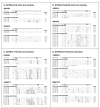Heavily glycosylated, highly fit SIVMne variants continue to diversify and undergo selection after transmission to a new host and they elicit early antibody dependent cellular responses but delayed neutralizing antibody responses
- PMID: 18680596
- PMCID: PMC2518139
- DOI: 10.1186/1743-422X-5-90
Heavily glycosylated, highly fit SIVMne variants continue to diversify and undergo selection after transmission to a new host and they elicit early antibody dependent cellular responses but delayed neutralizing antibody responses
Abstract
Background: Lentiviruses such as human and simian immunodeficiency viruses (HIV and SIV) undergo continual evolution in the host. Previous studies showed that the late-stage variants of SIV that evolve in one host replicate to significantly higher levels when transmitted to a new host. However, it is unknown whether HIVs or SIVs that have higher replication fitness are more genetically stable upon transmission to a new host. To begin to address this, we analyzed the envelope sequence variation of viruses that evolved in animals infected with variants of SIVMne that had been cloned from an index animal at different stages of infection.
Results: We found that there was more evolution of envelope sequences from animals infected with the late-stage, highly replicating variants than in animals infected with the early-stage, lower replicating variant, despite the fact that the late virus had already diversified considerably from the early virus in the first host, prior to transmission. Many of the changes led to the addition or shift in potential-glycosylation sites-, and surprisingly, these changes emerged in some cases prior to the detection of neutralizing antibody responses, suggesting that other selection mechanisms may be important in driving virus evolution. Interestingly, these changes occurred after the development of antibody whose anti-viral function is dependent on Fc-Fcgamma receptor interactions.
Conclusion: SIV variants that had achieved high replication fitness and escape from neutralizing antibodies in one host continued to evolve upon transmission to a new host. Selection for viral variants with glycosylation and other envelope changes may have been driven by both neutralizing and Fcgamma receptor-mediated antibody activities.
Figures





Similar articles
-
Changes in the extracellular envelope glycoprotein of variants that evolve during the course of simian immunodeficiency virus SIVMne infection affect neutralizing antibody recognition, syncytium formation, and macrophage tropism but not replication, cytopathicity, or CCR-5 coreceptor recognition.J Virol. 1998 Jan;72(1):209-17. doi: 10.1128/JVI.72.1.209-217.1998. J Virol. 1998. PMID: 9420217 Free PMC article.
-
Specific N-linked and O-linked glycosylation modifications in the envelope V1 domain of simian immunodeficiency virus variants that evolve in the host alter recognition by neutralizing antibodies.J Virol. 1997 Oct;71(10):7719-27. doi: 10.1128/JVI.71.10.7719-7727.1997. J Virol. 1997. PMID: 9311856 Free PMC article.
-
Limited contribution of mucosal IgA to Simian immunodeficiency virus (SIV)-specific neutralizing antibody response and virus envelope evolution in breast milk of SIV-infected, lactating rhesus monkeys.J Virol. 2010 Aug;84(16):8209-18. doi: 10.1128/JVI.00656-10. Epub 2010 Jun 2. J Virol. 2010. PMID: 20519381 Free PMC article.
-
Envelope sequence variation, neutralizing antibodies, and primate lentivirus persistence.Curr Top Microbiol Immunol. 1994;188:185-219. doi: 10.1007/978-3-642-78536-8_11. Curr Top Microbiol Immunol. 1994. PMID: 7523031 Review.
-
The history of SIVS and AIDS: epidemiology, phylogeny and biology of isolates from naturally SIV infected non-human primates (NHP) in Africa.Front Biosci. 2004 Jan 1;9:225-54. doi: 10.2741/1154. Front Biosci. 2004. PMID: 14766362 Review.
Cited by
-
High-Resolution Sequencing of Viral Populations during Early Simian Immunodeficiency Virus Infection Reveals Evolutionary Strategies for Rapid Escape from Emerging Env-Specific Antibody Responses.J Virol. 2018 Mar 14;92(7):e01574-17. doi: 10.1128/JVI.01574-17. Print 2018 Apr 1. J Virol. 2018. PMID: 29343575 Free PMC article.
-
Autologous neutralizing antibodies to the transmitted/founder viruses emerge late after simian immunodeficiency virus SIVmac251 infection of rhesus monkeys.J Virol. 2010 Jun;84(12):6018-32. doi: 10.1128/JVI.02741-09. Epub 2010 Mar 31. J Virol. 2010. PMID: 20357097 Free PMC article.
-
Continuous viral escape and selection by autologous neutralizing antibodies in drug-naive human immunodeficiency virus controllers.J Virol. 2009 Jan;83(2):662-72. doi: 10.1128/JVI.01328-08. Epub 2008 Nov 5. J Virol. 2009. PMID: 18987151 Free PMC article.
-
Feline immunodeficiency virus (FIV) neutralization: a review.Viruses. 2011 Oct;3(10):1870-90. doi: 10.3390/v3101870. Epub 2011 Oct 13. Viruses. 2011. PMID: 22069520 Free PMC article. Review.
References
-
- Shankarappa R, Margolick JB, Gange SJ, Rodrigo AG, Upchurch D, Farzadegan H, Gupta P, Rinaldo CR, Learn GH, He X, Huang XL, Mullins JI. Consistent viral evolutionary changes associated with the progression of human immunodeficiency virus type 1 infection. J Virol. 1999;73:10489–10502. - PMC - PubMed
Publication types
MeSH terms
Substances
Grants and funding
LinkOut - more resources
Full Text Sources
Molecular Biology Databases

